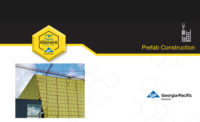King Open and Cambridge Street Upper Schools & Community Complex clearly makes the grade when it comes to sustainable design. The $130 million school and community complex in Cambridge, Massachusetts exemplifies how good design at the outset can drive energy efficiency, support the community, and even manage unexpected disruptions in the learning environment. It’s clear why this high-performing school was named recipient of the 2019 U.S. Green Building Council’s (USGBC) “Best of Massachusetts” award.
The first LEED v4 Platinum and net zero emissions school building in Massachusetts includes an elementary and middle school, a preschool and an extended-day school. As a partner with the City of Cambridge, the complex also serves the greater community. The 273,000-square-foot structure houses the Cambridge Public School’s district offices along with a public branch library, two pools and an underground parking garage. Outside the building, the grounds are home to one of the Northeast’s largest geothermal wellfields.
Opened in 2019, the complex consumes no fossil fuels and 60 percent of its energy is produced onsite. Highly efficient design features include a 74,000-square-foot photovoltaic (PV) solar array, PV sunshades and a network of 190 geothermal wells, with each loop 520 feet deep. Radiant heating and cooling are supplied via a ground source mechanical system. The complex is designed to perform at an Energy Use Intensity (EUI) of 25.1. A “winged” concept separates different functions housed at the facility. Structuring the complex into distinct sections means locations not in use during a particular day or season can operate at reduced energy levels.
“We were designing a municipal resource for Cambridge citizens to claim as their own. A seven-day facility that is open all year runs counter to the idea of reducing energy load, but made the challenge even more fun,” says Sindu Meier, AIA, LEED AP, BD+C, senior associate at William Rawn Associates, the Boston-based architecture firm of record. The deployment of geothermal and solar technologies are key drivers of energy performance. The geothermal wells reduce energy consumption by 54 percent. Passive supporting elements and design details contribute to the building’s efficiency. Meier notes that a first step when designing the tightest, most energy efficient building is to reduce the envelope size.
Installed materials also drive performance. High efficiency building products maximize natural light, and thermally isolated clip systems for the rain screen minimize thermal bridging. Mineral wool insulation supports thermal performance and long-term durability and addresses NFPA 285. The thermally isolated clip and 4 inches of Thermafiber® Rainbarrier® 45 mineral wool support continuous insulation in the exterior assembly of the complex.¹ Insulation in the exterior wall also helps mitigate urban traffic sound outside the complex.
New Learning
A few months after the complex received the USGBC-Massachusetts Green Building of the Year designation, the global pandemic spotlighted social distancing and clean environments. Design strategies implemented before the pandemic helped facilitate an efficient return to classes following lockdowns. A highly flexible design and systems, including generous corridors, break-out spaces and classroom technology, allowed the school to adapt to hybrid learning. “In the current COVID paradigm, outdoor rooms have become increasingly important to help provide a safe alternative to indoor classrooms,” says Meier.
Net zero and healthy design strategies overlap most when it comes to air distribution. The school’s ventilation system helped the complex bring students back into the facility without needing modifications to support indoor air quality.
Design and floorplan layout also support a healthy learning environment. Elementary and middle schools are placed in a neighborhood framework with large classrooms, learning breakout rooms and open areas to support collaboration and teamwork.
As part of the City of Cambridge’s commitment to become a Net Zero City by 2040, the complex’s performance serves multiple stakeholders. But some things can’t be foreseen. Viewed through the lens of a public health crisis, it is inspiring to see how the complex pivoted to support the student population and local community following the start of the COVID-19 pandemic.
“Even though we didn’t have the pandemic lens when we were designing the building, we had an eye on the healthy school vision and this design strategy helped meet the needs of the moment when students returned to the facility,” says Kate Bubriski, director of Sustainability and Building Performance at Arrowstreet Inc.
Outside the complex, healthy behaviors and social distancing are part of the design strategy. Two basketball courts, a bocce court, five playgrounds and an outdoor splash pad promote exercise and access to nature. Locating the parking underneath made two acres of open space available.
Design features serve as a practical opportunity to bring sustainability and the environment into lesson plans. For example, from their classrooms, students can see the PV array, the bioswales integrated into the civic plaza and the grey water system piping in the corridor ceiling areas. From a metric perspective, interactive building dashboards track energy production and energy and water usage in real time.
Light and Orientation Influence Design
Orientation and window-to-wall ratio are integral to achieving a high-performing building. A building’s orientation, along with the amount and placement of windows, can have a big influence on energy consumption and overall efficiency. Daylighting benefits must be balanced with the security and safety requirements a school demands. In some instances—particularly in a school—it is possible to over-daylight. The purpose of the building informed the massing and exterior envelope, allowing designers to achieve well-lit spaces with an open ethos.
A Community Connection
The complex served community members during the pandemic. For example, the public library’s open floorplan allowed it to serve as space for COVID-19 testing and administration of flu shots. The complex also functioned as a meal pick-up site for students and families experiencing food insecurity.
King Open/Cambridge Street Upper Schools & Community Complex is proof that thoughtful design strategies at the outset of a project can help support safe and healthy learning environments, even when the unexpected occurs. “Collaboration among architects, environmental consultants and manufacturers working together on this project demonstrates that teamwork, communication and early planning can help school districts and communities achieve very significant sustainability goals,” says Susan Raneri, sales leader at Owens Corning.
Reference
1. An equal 50/50 split of continuous insulation between Thermafiber®Rainbarrier® 45 mineral wool and other mineral wool products was used for this project.





Report Abusive Comment